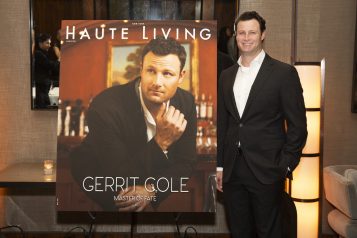But before diving into the “honey,” let’s start with the money. Maria went to NYU with the intention of getting her degree in economics, but, listening to the wise words of her mother, switched her focus to journalism during her junior year, keeping her minor in finance. While still at the university, she began an internship at CNN, which at the time was in its infancy compared to the more established stations, a fact that made Maria a bit apprehensive. “I didn’t want to work for CNN, frankly,” she recalls. “I wanted to work for the major networks—ABC, NBC. I thought that was where the power was. But actually, I was very lucky, because CNN was the best place to get my foot in the door.”
Due to CNN’s relative youth, it was not unionized, so Maria was able to become immersed in all aspects of news broadcasting, whereas at the likes of ABC or NBC, she would have been pigeonholed in one department. “At CNN, they really needed help,” she recalls. “The first Gulf War was about to begin, so I was able to get my hands on all sorts of jobs, from production assistant to writing.” Following graduation, she stuck around, despite the internship being unpaid. It was a risky venture that paid off tenfold.
While moonlighting in other positions to make ends meet, she worked her way through various positions at CNN, finally winding up in the business division. “Business television was really in its infancy,” she recalls. “At CNN, there were only a couple of financial shows, like Moneyline with Lou Dobbs [now called Lou Dobbs Tonight].” CNN was looking to expand the division, so Maria was given an editing and a finance test and landed a paid position. She began as a writer, producer, and assignment editor, garnering invaluable knowledge about the industry along the way.
In 1993, Maria made the move to CNBC where the station managers recognized the bankability of putting her in front of the camera. She knew early on what she wanted to accomplish—demystifying the world of finance—and she wanted to do it from the floor of the New York Stock Exchange, the intimidating source of mystery for anyone not personally involved in the trade. By being the first person to report live from the NYSE, she created an industry trend and countless others have followed in her footsteps down to the trading floor.
Today, she is looking to educate an entire new generation of future consumers. Likely drawing inspiration from the old cartoon Schoolhouse Rock!, the Money Honey is working on a line of educational programming for children that will tackle topics such as “What is a stock?”, “What is a bank?”, and “Why do I have to save?” The animated series will be targeted to children between the ages of eight and 12, because Maria feels this is an age where one begins to understand what money really is. “At eight years old, kids are finally beginning to want things, and they understand the concept that you need to pay for things,” she explains.


















